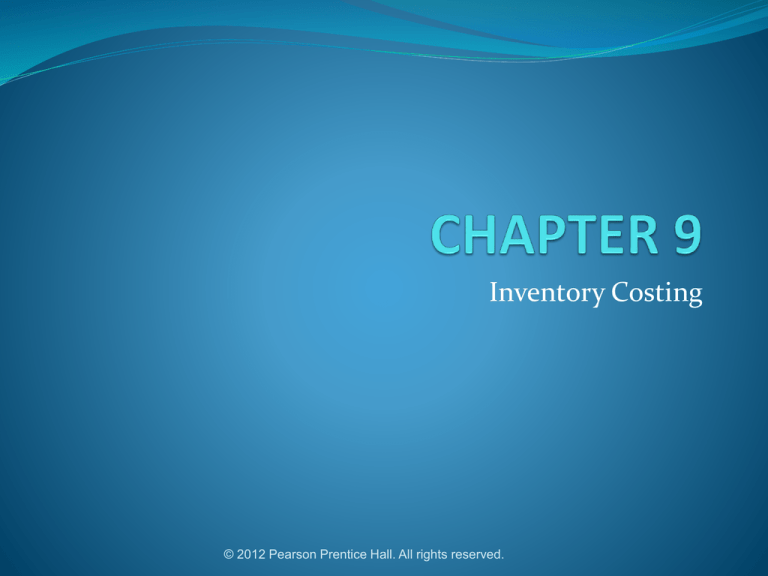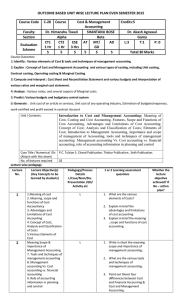
Inventory Costing
© 2012 Pearson Prentice Hall. All rights reserved.
Inventory Costing Choices: Overview
Absorption costing—product costs are capitalized;
period costs are expensed.
Variable costing—variable product and period costs
are capitalized; fixed product and period costs are
expensed.
Throughput costing—only direct materials are
capitalized; all other costs are expensed.
© 2012 Pearson Prentice Hall. All rights reserved.
Costing Comparison
Variable costing is a method of inventory costing in
which only variable manufacturing costs are included
as inventoriable costs.
Absorption costing is a method of inventory costing in
which all variable manufacturing costs and all fixed
manufacturing costs are included as inventoriable
costs.
© 2012 Pearson Prentice Hall. All rights reserved.
Differences in Income
Operating income will differ between absorption and
variable costing.
The amount of the difference represents the amount of
fixed product costs capitalized as inventory under
absorption costing, and expensed as a period costs
under variable costing.
© 2012 Pearson Prentice Hall. All rights reserved.
Comparative Income Statements
© 2012 Pearson Prentice Hall. All rights reserved.
Comparative Income Statements—
Three Years
© 2012 Pearson Prentice Hall. All rights reserved.
Comparative Income Effects
Are fixed product
costs inventoried?
Is there a
production-volume
variance?
Are classifications
between variable
and fixed costs
routinely made?
Variable Costing
Absorption Costing
No
Yes
No
Yes
© 2012 Pearson Prentice Hall. All rights reserved.
Yes
Infrequently
Comparative Income Effects
Variable Costing
Absorption Costing
Production = Sales
Equal
Equal
Production > Sales
Lower
Higher
Production < Sales
Higher
Lower
How do changes in
unit inventory cost
affect operating
income if…?
© 2012 Pearson Prentice Hall. All rights reserved.
Comparative Income Effects
What are the
effects on costvolume-profit for a
given level of fixed
costs and a given
contribution margin
per unit?
Variable Costing
Absorption Costing
Driven by:
unit level
of sales
Driven by:
Unit level of
sales
Unit level of
production
Chosen
denominator
level
1.
© 2012 Pearson Prentice Hall. All rights reserved.
2.
3.
Comparison of Alternative Inventory
Costing Systems
Variable Direct Manufacturing Cost
Actual Costing
Actual prices
X
Actual quantity
of inputs used
Normal Costing Standard Costing
Actual prices
X
Actual quantity
of inputs used
(c) 2012 Pearson Prentice Hall. All rights reserved.
Standard prices
X
Standard quantity
of inputs allowed
for actual output
achieved
Comparison of Alternative Inventory
Costing Systems
Variable Indirect Manufacturing Cost
Actual Costing
Actual variable
indirect rates
X
Actual quantity of
cost-allocation
bases used
Normal Costing Standard Costing
Budgeted variable
indirect rates
X
Actual quantity of
cost-allocation
bases used
(c) 2012 Pearson Prentice Hall. All rights reserved.
Standard variable
indirect rates
X
Standard quantity of
cost-allocation
bases allowed for
actual output
achieved
Comparison of Alternative Inventory
Costing Systems
Fixed Direct Manufacturing Cost
Actual Costing
Actual prices
X
Actual quantity
of inputs used
Normal Costing Standard Costing
Actual prices
X
Actual quantity
of inputs used
(c) 2012 Pearson Prentice Hall. All rights reserved.
Standard prices
X
Standard quantity
of inputs allowed
for actual output
achieved
Comparison of Alternative Inventory
Costing Systems
Fixed Indirect Manufacturing Cost
Actual Costing
Actual fixed
indirect rates
X
Actual quantity
of cost-allocation
bases used
Normal Costing Standard Costing
Budgeted fixed
indirect rates
X
Actual quantity
of cost-allocation
bases used
(c) 2012 Pearson Prentice Hall. All rights reserved.
Standard fixed
indirect rates
X
Standard quantity
of cost-allocation
bases allowed for
actual output
achieved
Performance Issues and Absorption Costing
Managers may seek to manipulate income by
producing too many units.
Production beyond demand will increase the
amount of inventory on hand.
This will result in more fixed costs being capitalized
as inventory.
That will leave a smaller amount of fixed costs to be
expensed during the period.
Profit increases, and potentially, so does a manger’s
bonus.
© 2012 Pearson Prentice Hall. All rights reserved.
Inventories and Costing Methods
One way to prevent the unnecessary buildup of
inventory for bonus purposes is to base manager’s
bonuses on profit calculated using variable costing.
Drawback: complicated system of producing two
inventory figures—one for external reporting and the
other for bonus calculations.
© 2012 Pearson Prentice Hall. All rights reserved.
Other Manipulation Schemes Beyond
Simple Overproduction
Deciding to manufacture products that absorb the
highest amount of fixed costs, regardless of demand
(“cherry-picking”)
Accepting an order to increase production, even
though another plant in the same firm is better suited
to handle that order
Deferring maintenance
© 2012 Pearson Prentice Hall. All rights reserved.
Management Countermeasures for Fixed
Cost Manipulation Schemes
Careful budgeting and inventory planning
Incorporate an internal carrying charge for inventory
Change (lengthen) the period used to evaluate
performance
Include nonfinancial as well as financial variables in
the measures to evaluate performance
© 2012 Pearson Prentice Hall. All rights reserved.
Income Effects of Inventory Buildup
© 2012 Pearson Prentice Hall. All rights reserved.
Extreme Variable Costing:
Throughput Costing
Throughput costing (super-variable costing) is a
method of inventory costing in which only direct
material costs are included as inventory costs. All
other product costs are treated as operating expenses.
© 2012 Pearson Prentice Hall. All rights reserved.
Throughput Costing Illustrated
© 2012 Pearson Prentice Hall. All rights reserved.
Costing Systems Compared
© 2012 Pearson Prentice Hall. All rights reserved.
© 2012 Pearson Prentice Hall. All rights reserved.




